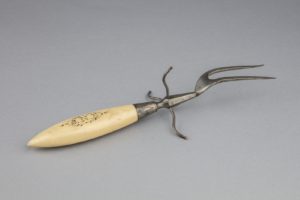
Originating from a set of other ivory-handled Will & Finck utensils in the late 1800s, this fork is monogrammed with the initials of its previous owner, John Norton Pomeroy. Pomeroy was an accomplished politician and Burlington native, born in 1792, as well as a graduate of the University of Vermont in 1809.
According to American social etiquette, it was important that the lady of the house not only have an enticing array of food, but also the correct matching cutlery. In the event of a dinner party, both the host and the hostess often took on roles in which the hostess served as her male counterpart handled the carving and ensuring the guests’ entertainment.
In the following passage from his 1890 autobiography titled Reminiscences and Recollections of “Brick” Pomeroy, Mark Mills “Brick” Pomeroy writes about carving the meat as a staple of late 19th century dining etiquette.
“I agreed with him…to carve the meat every day at dinner, so that I was conducted to the chair at the head, where, armed with the large carving knife and fork, my first duty was to make inroads upon a piece of roast beef.
At home I had been taught to cut things into chunks, and thinking this to be the proper way, succeeded, before the guests and boarders came in, in converting a large piece of roast beef into several brick-shaped pieces of meat, congratulating myself upon the fineness with which the distribution was made. When these chunks were passed on plates to the boarders, the muttering of distant thunder was not more suggestive than were the remarks made by those who preferred good roast beef and thin slices. An elderly man, named Taylor, remarked that none but a fool would cut meat in such a manner, He was very indignant, and called the landlord in from the bar-room to apologize for the awkwardness of his new carver, and he was kind enough to tell me that hereafter instead of cutting meat into chunks, the proper thing to do was to shave it off in nice thin slices and be very careful in laying it on the plate—to be sure to have that side uppermost most tempting to the gaze of the receiver.”
